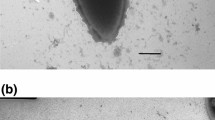Abstract
An enrichment culture which converted acetate to methane at 60°C was obtained from a thermophilic anaerobic bioreactor. The predominant morphotype in the enrichment was a sheathed gas-vacuolated rod with marked resemblence to the mesophile Methanothrix soehngenii. This organism was isolated using vancomycin treatments and serial dilutions and was named Methanothrix sp. strain CALS-1. Strain CALS-1 grew as filaments typically 2–5 cells long, and cultures showed opalescent turbidity rather than macroscopic clumps. The cells were enclosed in a striated subunit-type sheath and there were distinct cross-walls between the cells, similar to M. soehngenii. The gas vesicles in cells were typically 70 nm in diameter and up to 0.5 μm long, and were collapsed by pressures over 3 atm (ca. 300 kPa). Stationary-phase cells tended to have a higher vesicle content than did growing cells, and occasionally bands of cells were seen floating at the top of the liquid in stationary-phase cultures. Acetate was the only substrate of those tested which was used for methanogenesis by strain CALS-1, and acetate was decarboxylated by the aceticlastic reaction. The optimum temperature for growth of strain CALS-1 was near 60°C (doubling time=24–26 h), with no growth occurring at 70°C and 37°C. The optimum pH value for growth was near 6.5 in bicarbonate/CO2 buffered medium and no growth occurred at pH 5.5 or pH 8.4. No growth was obtained below pH 7 when the medium was buffered with 20 mM phosphate. Strain CALS-1 grew in a chemically defined medium and required biotin. Sulfide concentrations over 1 mM were inhibitory to the culture, and growth was more rapid with 1 mM 2-mercaptoethane sulfonate (coenzyme M) or 1 mM titanium citrate as an accessory reductant than with 1 mM cysteine. It is likely that strain CALS-1 represents a new species in the genus Methanothrix.
Similar content being viewed by others
References
Ahring BK, Westermann P (1984) Isolation and characterization of a thermophilic, acetate-utilizing methanogenic bacterium FEMS Microbiol Lett 25: 47–52
Ahring BK, Westermann P (1985) Methanogenesis from acetate: physiology of a thermophilic acetate-utilizing methanogenic bacterium. FEMS Microbiol Lett 28: 15–19
Balch WE, Fox GE, Magrum LJ, Woese CR, Wolfe RS (1979) Methanogens: reevaluation of a unique biological group. Microbiol Rev 43: 260–296
Barker HA (1936) Studies upon the methane-producing bacteria. Arch Microbiol 7: 420–438
Bhatnagar L, Henriquet M, Zeikus JG, Aubert JP (1984) Utilization of mercapto-2-ethanol as a medium reductant for determination of the metabolic response of methanogens towards inorganic sulfur compounds. FEMS Microbiol Lett 22: 155–158
Brummeler E ten, Pol LWJ, Dolfing J, Lettinga G, Zehnder AJB (1985) Methanogenesis in an upflow anaerobic sludge blanket reactor at pH 6 on an acetate-propionate mixture. Appl Environ Microbiol 49: 1472–1477
Fathepure BZ (1983) Isolation and characterization of an aceticlastic methanogen from a biogas digester. FEMS Microbiol Lett 19: 151–156
Huser BE, Wuhrmann K, Zehnder AJB (1982) Methanothrix soehngenii gen. nov. sp. nov., a new acetotrophic non-hydrogenoxidizing methane bacterium. Arch Microbiol 132: 1–9
Kellenberger E, Ryter A, Sechaud J (1958) Electron microscope study of DNA plasms. J Biophys Biochim Cytol 4: 671–678
Mah RA, Smith MR, Baresi L (1978) Studies on an acetate fermenting strain of Methanosarcina. Appl Environ Microbiol 35: 1174–1184
Miller TL, Wolin MJ (1985) Methanosphaera stadtmaniae gen. nov. sp. nov.: a species that forms methane by reducing methanol with hydrogen. Arch Microbiol 141: 116–122
Nozhevnikova AN, Chudina VI (1985) Morphology of the thermophilic acetate methane bacterium Methanothrix thermoacetophila sp. nov. Microbiol 53: 618–624
Nozhevnikova AN, Yagodina TG (1983) A thermophilic acetate methane-producing bacterium. Microbiol 51: 534–541
Patel GB (1984) Characterizaton and nutritional properties of Methanothrix concilii sp. nov., a mesophilic aceticlastic methanogen. Can J Microbiol 30: 1383–1396
Rohde PA (ed) (1968) BBL Manual of products and laboratory procedures. BioQuest, Division of Becton, Dickenson and Co., Cockeysville, MD
Smith MR, Mah RA (1980) Acetate as sole carbon and energy source for growth of Methanosarcina strain 227. Appl Environ Microbiol 39: 993–999
Sowers KR, Ferry JG (1985) Trace metal and vitamin requirements of Methanococcoides methylutens grown with trimethylamine. Arch Microbiol 142: 148–151
Stackebrandt E, Seewaldt E, Ludwig W, Schleifer K-H, Husar BA (1982) The phylogenetic position of Methanothrix soehngenii elucidated by a modified technique of sequencing oligonucleotides from 16S rRNA. Zentbl Bakt Hyg I Abt Orig C 3: 90–100
Touzel JP, Petroff D, Albagnac G (1985) Isolation and characterization of a new thermophilic Methanosarcina, the strain CHTI 55. Syst. Appl Microbiol 6: 66–71
Walsby AH (1975) Gas vesicles. Ann Rev Pl Physiol 26: 427–439
Weimer PJ, Zeikus JG (1978) Acetate metabolism in Methanosarcina barkeri. Arch Microbiol 119: 175–182
Zehnder AJB, Wuhrmann K (1976) Titanium (III) citrate as a nontoxic oxidation reduction buffering system for the culture of obligate anaerobes. Science 194: 1165–1166
Zehnder AJB, Huser BA, Brock TD, Wuhrmann K (1980) Characterization of an acetate-decarboxylating, non-hydrogenoxidizing methane bacterium. Arch Microbiol 124: 1–11
Zeikus JG (1977) The biology of methanogenic bacteria. Bacteriol Rev 41: 514–541
Zhilina TN, Zavarzin TA (1979) Comparative cytology of methanosarcinae and description of Methanosarcina vacuolata sp. nov. Microbiol 48: 279–285
Zinder SH, Koch M (1984) Non-aceticlastic methanogenesis from acetate: acetate oxidation by a thermophilic syntrophic coculture. Arch Microbiol 138: 263–272
Zinder SH, Mah RA (1979) Isolation and characterization of a thermophilic strain of Methanothrix unable to use H2−CO2 for methanogenesis. Appl Environ Microbiol 38: 996–1008
Zinder SH, Anguish T, Cardwell SC (1984a) Effects of temperature on methanogenesis in a thermophilic (58° C) anaerobic digestor. Appl Environ Microbiol 47: 808–813
Zinder SH, Cardwell SC, Anguish T, Lee M, Koch M (1984b) Methanogenesis in a thermophilic anaerobic digestor: Methanothrix sp. as an important aceticlastic methanogen. Appl environ Microbiol 47: 796–807
Zinder SH, Sowers KR, Ferry JG (1985) Methanosarcina thermophila sp. nov., a thermophilic acetotrophic methane-producing bacterium. Int J Syst Bacteriol 35: 522–523
Author information
Authors and Affiliations
Rights and permissions
About this article
Cite this article
Zinder, S.H., Anguish, T. & Lobo, A.L. Isolation and characterization of a thermophilic acetotrophic strain of Methanothrix . Arch. Microbiol. 146, 315–322 (1987). https://doi.org/10.1007/BF00410928
Received:
Accepted:
Issue Date:
DOI: https://doi.org/10.1007/BF00410928




